Oxford to Northmoor
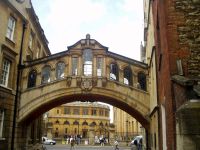
Oxford to Northmoor |  |
| Upstream: Northmoor to Tadpole Bridge | Back to Main Page | Downstream: Abingdon to Oxford |
Introduction
The stunning city of Oxford is the start point for this walk, the last city on the path to the source, and one that is well worth taking a look round. From here to the source the path is now very rural, passing through only a couple of small towns. The rural feel starts almost immediately from Oxford where the path goes through open meadows, past the remains of Godstow Abbey, after which the Thames becomes noticeably thinner as it twists round the many corners, on the way to Swinford, with it's lovely bridge. This walk continues from Swinford to Northmoor Lock with the village a mile or two inland.
Getting to the Start
Oxford is easy to get to, with good road and public transport links. By car, if heading from the south, Oxford can be reached by exiting junction 8 of the M40 onto the A40, taking you to the ring-road around Oxford. From the North exit the M40 at junction 9 and join the A34. The A44, A40 and A34 also pass round the edge of Oxford. Parking in the city centre is very limited however, so it is a good idea to use one of the park and ride services. These are well signed from all of the main roads into Oxford and are also cheaper than parking nearer the city centre.
Oxford also has excellent public transport, but enjoy it whilst it lasts, as from Oxford to the source, public transport is far more limited! Oxford station is to the west of the city centre, but very close to the Thames Path. Virgin Trains operate frequent trains to Oxford from Bournemouth, Southampton, Winchester, Basingstoke, Reading, Banbury, Leamington, Birmingham, The Midlands and the North as well as occasional services from Brighton and Gatwick Airport. First Great Western Link operate frequent services to Oxford from London, Slough, Maidenhead, Reading and Didcot. They also operate services from Hereford, Stratford-upon-Avon, Worcester and the Cotswolds to Oxford and local services between Oxford, Reading and London Paddington and a branch line to Bicester. Connections onto many other services are available at Reading.
Oxford also has excellent bus services, including very frequent coach services to London (even running throughout the night), known as the Oxford Espress and Oxford Tube and long-distance services to Bicester, Buckingham, Milton Keynes, Bedford and Cambridge. Local buses also run frequently to Abingdon, Didcot, Witney and Bicester, as well as many other towns and villages nearby. All these bus services are operated by Oxford Bus, Stagecoach in Oxford and Thames Travel.
The Walk
The stunning city of Oxford is the start for this part of the Thames Path and it's worth spending some time looking round the city, although to do it justice you really need at least a day. The many beautiful buildings of the colleges of the University of Oxford dominate the skyline, making Oxford known as the city of dreaming spires.
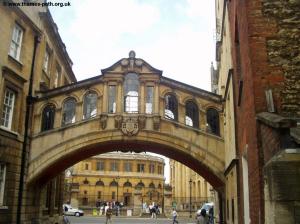 |
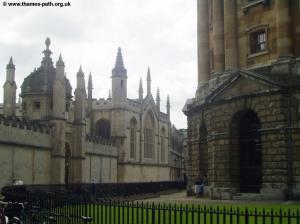 |
| The Bridge of Sighs | Near the Radcliffe Camera |
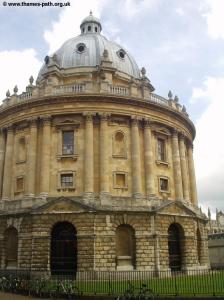 |
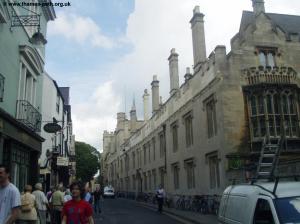 |
| The Radcliffe Camera | Oxford City Centre |
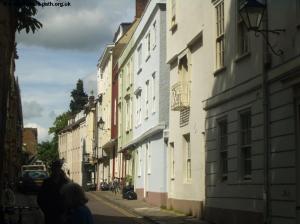 |
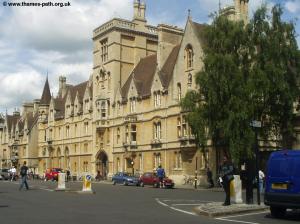 |
| Oxford City Centre | Oxford City Centre |
The Thames Path from Oxford continues from the other side of the road at Osney Bridge. Here you'll pass behind river-side cottages on one side, whilst the other side of the river are allotments, a surprising scene considering how close to the city centre this is. At the end of the row of cottages is a footbridge over where the Oxford Canal joins the Thames.
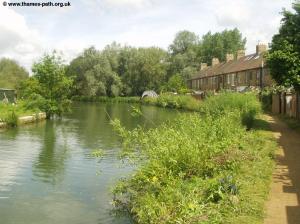 |
| The Thames path out of Oxford |
Here you begin to leave Oxford behind, and soon there is a boat yard to the right. Here you're walking on an island (Fiddler's Island) between the Oxford Canal and the boat yard on the right, and the Thames to your left. Soon there is a footbridge to the right, with a public footpath, crossing the canal from the boatyard, however the Thames path continues straight on here, on towards the red Medley Footbridge, which the Thames path crosses to re-join the south bank of the river.
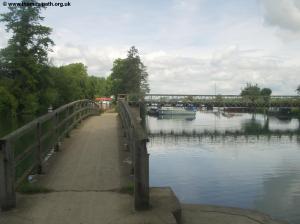 |
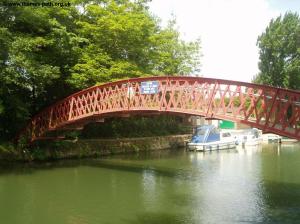 |
| The bridge over the boatyard | Medley Footbridge |
From the top of the bridge you can see that ahead the Thames becomes wide, with low-lying meadows across to the right, known as Port Meadow, a contrast to the tree-lined river behind.
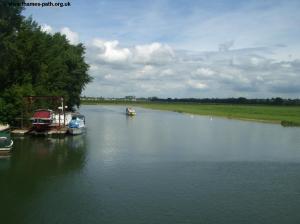 |
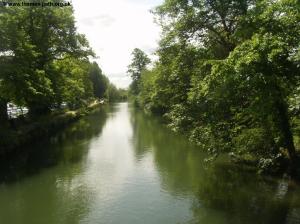 |
| Port Meadow Ahead | Looking back from Medley Footbridge |
The next mile or so is lovely peaceful walking, with the expansive meadows on the right of the Thames, passing near Binsey, where there is a pub, and a small footbridge, as the path comes towards Godstow Lock. Here part of the Thames flows off to the right, re-joining the main course of the river further upstream at King's Weir. The lock is typical of Thames locks, but is the last electrically-operated lock on the Thames and beyond it you'll see all that remains of Godstow Abbey, built in 1133. The remains of the abbey are freely open for you to walk around.
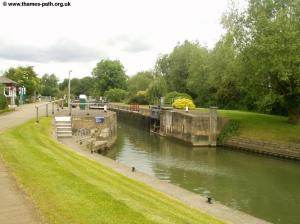 |
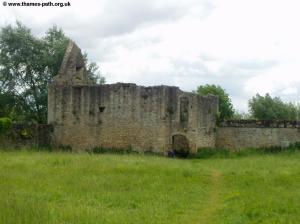 |
| Godstow Lock - the last electric lock | The remains of Godstow Abbey |
Just beyond the abbey you come to the small bridge, leading to the left to Wytham and to the right to the pretty Trout Inn and beyond to Wolvercote. Beyond the bridge is the more modern road bridge, carrying the A34.
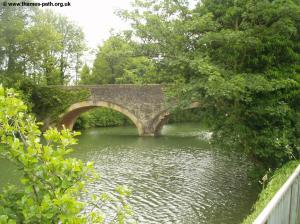 |
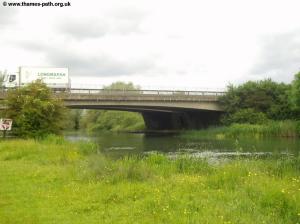 |
| Godstow Bridge | The modern A34 bridge |
Beyond the A34 bridge the Thames becomes more peaceful again, passing through farm land as we come towards one of the most curved parts of the navigable Thames towards Kings Lock. Kings Lock is the first manually operated lock on the path and like many of the locks has immaculately kept gardens.
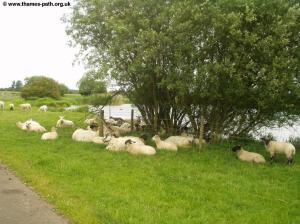 |
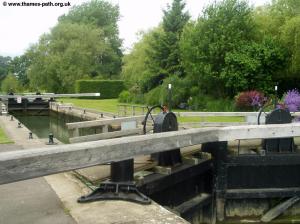 |
| Sheep in a field approaching Kings Lock | Kings Lock |
At Kings Lock the part of the Thames that branched off just before Godstow Lock now rejoins the Thames. Beyond the lock the path is relatively straight again until Hagley Pool where there is a small weir and footbridge, where the Wytham Stream now rejoins the Thames. Soon the path is passing the edge of Wytham Great Wood, which has a network of paths through it if you wish to explore further.
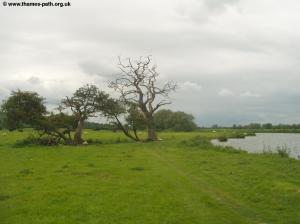 |
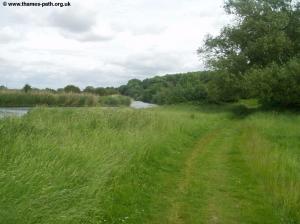 |
| The Thames Path beyond Kings Lock | The Thames Path near Wytham Great Wood |
As you leave the wood behind you can see the weir and lock at Eynsham ahead. A footpath (not the Thames path) also goes across the weir, so you can walk above the weir and enjoy the sound of the water flowing over the weir.
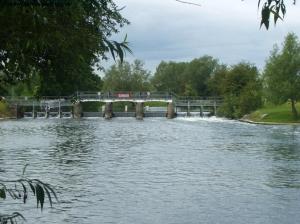 |
| Eynsham Weir |
Beyond the lock is one of the most beautiful bridges on the Thames, Swinford Bridge. This lovely sandstone bridge was completed in 1777 and is still privately owned. Motorists crossing the bridge still have to pay a toll to cross this bridge, although at only 5p it does make me wonder if the cost of collecting the toll is much less than the money made from it! Pedestrians can cross for free though.
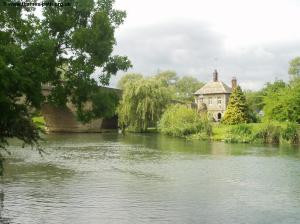 |
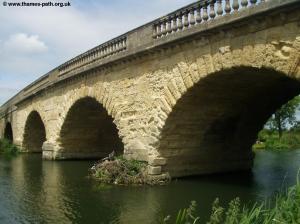 |
| Swinford Bridge and Toll House | Swinford Bridge |
Beyond Swinford bridge, the Thames becomes increasingly shallow and narrow round the many loops and turns ahead. The extent of the turns means that you can still see Swinford Bridge behind you for quite some time. Although now thin and narrow, this part of the river is still well used by boats, now mostly traditional narrow boats, it takes some time for them to negotiate all the turns. At one point you briefly have to leave the banks of the Thames (due to erosion), joining the road past Oxford Cruisers and then turning back to the right shortly after joining the road, to return to the banks of the Thames.
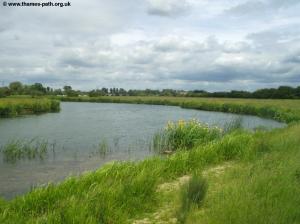 |
| The Thames beyond Swinford Bridge - the bridge can still be seen in the distance |
Soon you arrive at Pinkhill Lock, where the path crosses to the other bank, first via the bridge over the lock gates, then over the weir bridge.
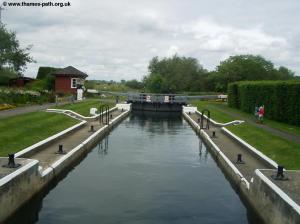 |
| Pinkhill Lock |
Beyond the lock the path briefly leaves the banks of the river, rejoining it at the next loop. Just beyond the opposite bank of the river is Farmoor Reservoir. Soon the path again leaves the banks of the river, heading off inland through a field, heading diagonally through the first field and into the second where you then join a farm track turning to the right. Soon you come to a junction and here there are signs for the bridle-path to Stanton Harcourt, an attractive village a mile or two inland. The Thames path turns off to the left again on a farm track, passing Tawney's Farm on the right. Soon you emerge onto the small road where you turn left. At the junction where the road turns off to the right, continue straight on, past the caravan site to rejoin the Thames at the Ferryman Inn. Here the publican of the fairly modern pub provides a ferry service across the Thames.
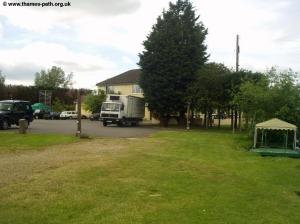 |
| The Ferryman Inn |
Beyond the caravan site, the Thames path now continues next to the river all the way to Northmoor Lock, a pleasant walk through the edge of fields with both banks of the river remaining undeveloped. The path can get quite overgrown along this stretch though. Soon you see Northmoor Lock approaching, marking the end of this walk. To get to Northmoor Village, a little over a mile away inland, retrace your steps until just after you pass under the power lines, and there is a footpath along the left edge of the first field, crossing the gap between the fields, then turning right where there is a gate, becoming a wide farm track. This track eventually emerges at the eastern edge of the village, so turn left when you emerge onto the road to get to the centre of the village.
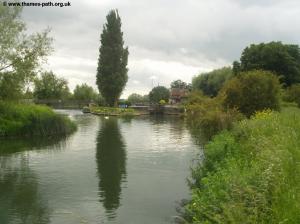 |
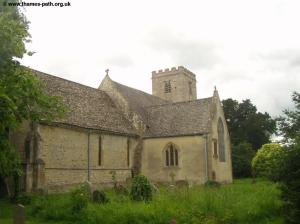 |
| Northmoor Lock | Northmoor Church |
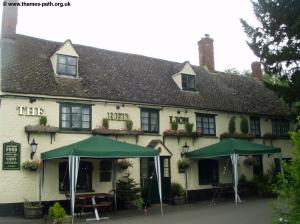 |
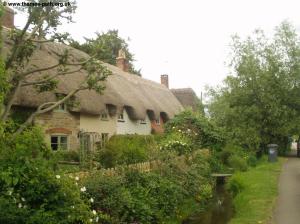 |
| The Red Lion, Northmoor | Northmoor |
Getting Back
Northmoor is a small village and as such has very limited public transport (in common with most of the other villages nearby). Stagecoach in Oxford service 18 serves the village on Mondays - Saturdays. This services runs from Oxford to Bampton or Witney, with some buses going on to Broadshires. The service runs approximately hourly, however only about half of the buses serve Northmoor, although those that do also serve Bablockhythe, and Standlake. At the time of writing (summer 2004) buses run from Northmoor to Bampton (Square) at 12:38, 13:38, 14:38, 16:43 (Saturday only), 16:53 (Monday - Friday only), and 18:33. In the opposite direction back to Oxford, buses currently run at 07:33 (Monday - Friday only), 07:43 (Saturday only), 09:31, 10:31, 11:31, 12:31 and 16:36. The buses all stop by The Red Lion pub in the village. Due to the infrequent bus service it is advisable to find the telephone number of a local taxi company in case you miss the last bus (or have a long wait). Almost all buses on route 18 (even those that don't serve Northmoor) do stop at Stanton Harcourt, another alternative. Also you should note the number of Stagecoach Oxford, which is 01865 772250 and the National Traveline number, which is 0870 608 2 608 who will be able to give you the up to date timetable.
Links
The following web sites provide information on the area.
Every effort is made to ensure the accuracy of information on this site, but liability will not be assumed in the event of any inaccuracies. Use of the information on this site is at your own risk. If you find any errors, please use the link below. The text and photographs on this web site are all Copyright © and may not be reproduced without prior permission